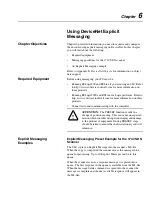
DeviceNet Objects
B-5
Class Code 05
hex
—
Connection
The Connection Class allocates and manages the internal resources
associated with both I/O and Explicit Messaging Connections. The
specific instance generated by the Connection Class is referred to as a
Connection Instance
or a
Connection Object
.
Important:
An externally visible interface to the Connection Class
across Explicit Messaging Connections exists. Unless otherwise
noted, all services/attributes noted in the following sections are
accessible using Explicit Messaging.
A Connection Object within a particular module actually represents
one of the end-points of a Connection. It is possible for one of the
Connection end-points to be configured and “active” (e.g.,
transmitting) without the other end-point(s) being present.
Connection Objects are used to model the communication specific
characteristics of a particular Application-to-Application(s)
relationship. A specific Connection Object Instance manages the
communication-specific aspects related to an end-point.
A Connection Object on DeviceNet uses the services provided by a
Link Producer and/or Link Consumer to perform low-level data
transmission and reception functions.
Class Attributes
Not supported
Instance Attributes
Attr.
ID
Attribute
Access
Data type
Description
1
State
Get
USINT
State of the connection as defined in the
DeviceNet specification
2
Instance_Type
Get
USINT
Indicates I/O or Messaging connection
3
transportclass_tri
gger
Get
BYTE
The Transport Class Trigger for this instance
4
Produced Cnxn
ID
Get
UINT
CAN Identifier to transmit on
5
Consumed Cnxn
ID
Get
UINT
CAN Identifier to receive on
6
Initial Comm Char
Get
BYTE
Defines the DeviceNet message groups that the tx/
rx Cnxn’s apply
7
Produced Cnxn
Size
Get
UINT
Max bytes to transmit across this connection
8
Consumed Cnxn
Size
Get
UINT
Max bytes to receive across this connection
9
EPR
Get/Set
UINT
Expected Packet Rate
12
Watchdog Action
Get
USINT
How to handle inactivity/watchdog timeouts
Summary of Contents for Allen-Bradley 842D
Page 10: ...P 6 Using this Manual Notes...
Page 18: ...3 4 Configuring the DeviceNet Encoder DIP Switches Notes...
Page 56: ...I 4 Index Notes...












































